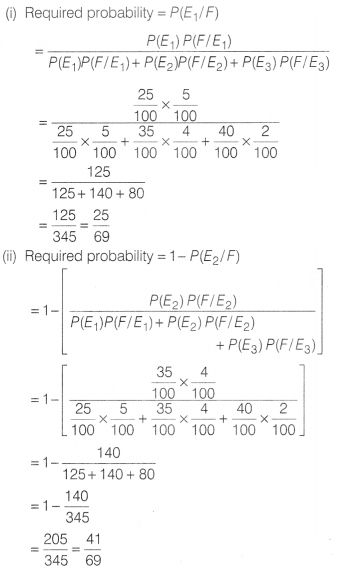CBSE Sample Papers for Class 12 Maths Set-11
Class 12thCBSE Sample Papers for Class 12 Maths Set-11
CBSE Sample Papers for Class 12 Maths Set 11 with Solutions
Time Allowed: 3 Hours
Maximum Marks: 80
General Instructions:
- This question paper contains – five sections A, B, C, D and E. Each section is compulsory. However, there are internal choices in some questions.
- Section A has 18 MCQ’s and 02 Assertion-Reason based questions of 1 mark each.
- Section B has 5 Very Short Answer (VSA) type questions of 2 marks each.
- Section C has 6 Short Answer (SA) type questions of 3 marks each.
- Section D has 4 Long Answer (LA) type questions of 5 marks each.
- Section E has 3 source based/case/passage based/intergrated units of assessment (4 marks each) with sub-parts.
Section
A
(Multiple Choice Questions)
Each question carries 1 mark
Question 1.
If order and degree of the differential equation
(\(\frac{dy}{dx}\))4 + 3x\(\frac{d^2y}{dx^2}\)= 0 is m and n
respectively, then m – n is equal to
(a) 1
(b) 2
(c) 3
(d) 0
Solution:
(a) We have, (\(\frac{dy}{dx}\))4 +
3x\(\frac{d^2y}{dx^2}\) = 0
∴ Order = 2 ⇒ m = 2
and degree = 1 ⇒ n = 1
∴ m – n = 2 – 1 = 1
Question 2.
The angle between the unit vectors \(\hat{a}\) and
\(\hat{b}\), given that |\(\hat{a}+\hat{b}\)| = 1, is
(a)
\(\frac{\pi}{3}\)
(b) \(\frac{\pi}{2}\)
(c) \(\frac{2\pi}{3}\)
(d)
–\(\frac{\pi}{3}\)
Solution:
(c) We have, |\(\hat{a}+\hat{b}\)| = 1
Let
θ be the angle between a\(\hat{a}\) and \(\hat{b}\).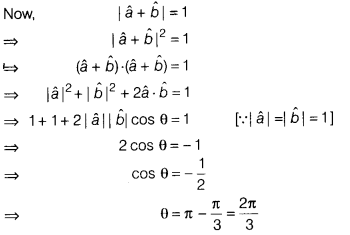
Question 3.
The function f : R → R given by f (x) = cos x ∀ x ∈ R, is
(a) one-one
(b) not one-one
(c) bijective
(d) None of these
Solution:
(b) We know that
f(0) = cos 0 = 1 and f(2π) = cos2π = 1
So,
different elements in R may have the same image.
Hence, f is not one-one.
Question 4.
If f(x) = x|x|, then f'(x) is equal to
(a) x²
(b) 2x
(c) 2|x|
(d) 1
Solution:
(c) Given, f(x) = x|x|
Question 5.
The value of xdy + (x – 1)dx = 0 is
(a) y = logx – x +C
(B) y = logx + x + C
(c) y = -logx + C
(d) y = -logx – x + C
Solution:
(a) We have, xdy + (x – 1)dx = 0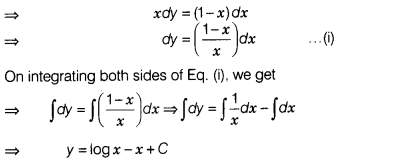
Question 6.
If f(x) = 2|x| + 3|sin x| + 6, then the right hand derivative
of f (x) at x – 0, is
(a) 1
(b) 5
(c) 3
(d) 4
Solution:

Question 7.
Let R – {(a, a³): a is the prime number less than5} be a
relation, then the range of R is
(a) {2, 3}
(b) {8, 27}
(c) {2}
(d)
{2, 3, 8, 27}
Solution:
(b) Given, R = {(a, a³): a is prime number less
than 5}
⇒ R = {(2, 8), (3, 27)}
Hence, range of R = {8, 27}
Question 8.
If a matrix A is both symmetric and skew-symmetric, then A
is
(a) null matrix
(b) identity matrix
(c) diagonal matrix
(d) None
of these
Solution:
(a) Null matrix
Question 9.
The value of tan [\(\frac{1}{2}\)
cos-1(\(\frac{\sqrt5}{3}\))]
Solution: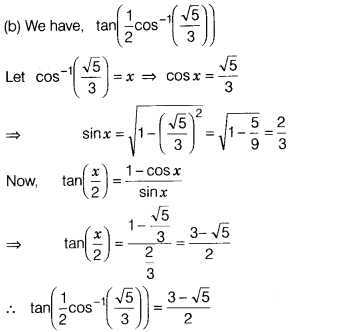
Question 10.
If A ≡ (2, 3, 1) and B ≡ (5, 4, 2), then the direction ratios
of \(\vec{AB}\) are
(a) -3, 1, 1
(b) 3, 1, 1
(c) 5, 4, 2
(d) 3, 0,
1
Solution:
(b) Given, A ≡ (2, 3, 1) and B ≡ (5, 4, 2)
∴ Direction
ratios of \(\vec{AB}\) are
(5 – 2), (4 – 3), (2 – 1) i.e. 3, 1, 1
Question 11.
A kite is moving horizontally at a height of 151.5 m. If the
speed of kite is 10 m/sec, then the rate at which the string is being let out
when the kite is 250 m away from tjie boy who is flying the kite and the height
of the boy 1.5 m is
(a) 4 m/sec
(b) 6 m/sec
(c) 7 m/sec
(d) 8
m/sec
Solution:
(d) Let AB be the height of kite and DE be the height of
the boy.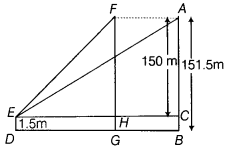
Let DB = x = EC
∴ \(\frac{dx}{dt}\) = 10 m/sec
Let AE =
y
∵ AB = 151.5 m
∴ AC = AB – BC = 151.5 – 1.5m = 150 m
AC² + EC² = AE²
[by Pythagoras theorem]
⇒ 150² + x² = y²
On differentiating both sides
w.r.t. x, we have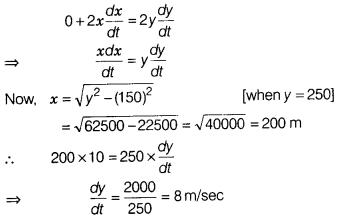
Question 12.
The value of
∫sin5(\(\frac{x}{2}\)).cos(\(\frac{x}{2}\)) dx is
Solution: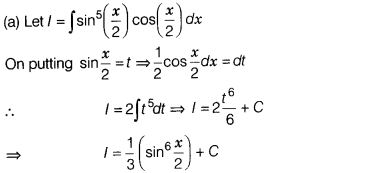
Question 13.
A right circular cylinder which is open at the top and has a
given surface area, will have the greatest volume, if its height h and radius r
are related by
(a) 2h = r
(b) h = 4r
(c) h = 2r
(d) h = r
Solution:
(d) Surface area, S = 2πrh + πr² …….(i)
and V = nπ²h
…….(ii)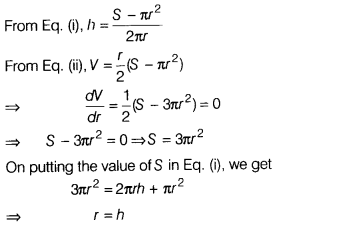
Question 14.
The value of tan-1{tan\(\frac{15\pi}{4}\)} is
(a) \(\frac{\pi}{4}\)
(b) \(\frac{3\pi}{4}\)
(c) –\(\frac{\pi}{4}\)
(d)
π
Solution:
(c) We have,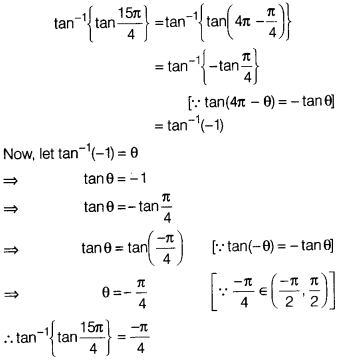
Question 15.
If [x] denotes the greatest integer function, then
\(\int_0^{3/2}\) [x²] dx is equal to
(a) √2 – 2
(b) 2 – √2
(c) √2
(d) √2 + 2
Solution: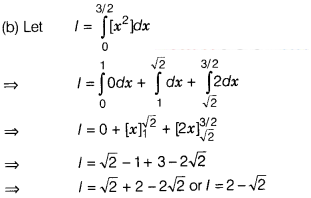
Question 16.
If A is symmetric matrix, then B’ AB is
(a) symmetric
matrix
(b) skew symmetric matrix
(c) scalar matrix
(d) None of the
above
Solution:
(a) (B’AB)’ = (AB)'(B’)’ = B’A’B = B’AB [∵ A’ = A]
Question 17.
The direction ratios of the line segment joining
P(x1, y1, z1) andQ(x2,
y2, z2) are
(a) x1 – x2,
y1 – y2, z1 – z2
(b)
x2 – x1, y2 – y1, z2 –
z1
(c) Both (a) and (b)
(d) None of the above
Solution:
(c) The direction ratios of the line segment joining
P(x1,
y1, z1 and Q(x2, y2,
z2)may be taken as
x2 – x1 >
y2 – y1 z2 – z1 or x1 –
x2, y1 – y2, z1 – z2.
Question 18.
The area of the triangle whose two sides are represented by
the vectors 2\(\hat{i}\) and – 3\(\hat{j}\) is
(a) 6 sq units
(b) 3 sq
units
(c) 2 sq units
(d) 1 sq unit
Solution: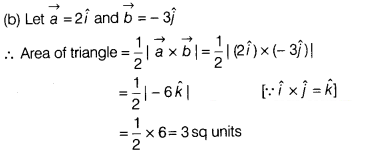
Assertion-Reason Based Questions
In the following questions, a statement
of Assertion (A) is followed by a statement of Reason (R). Choose the correct
answer out of the following choices.
(a) Both A and R are true and R is the
correct explanation of A
(b) Both A and R are true but R is not the correct
explanation of A
(c) A is true but R is false
(d) A is false but R is
true
Question 19.
Reason (R) Two different matrices can be added only if they
are of same order.
Solution: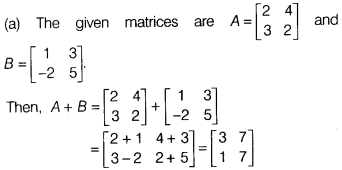
Hence, Assertion (A) is true. Reason (R) is also true and it
is the correct explanation of Assertion (A).
Question 20.
Assertion (A) Let f : R → R be defined by f(x) = x² + L Then,
pre-images of 17 are ± 4.
Reason (R) A function f : A → B is called a one-one
function, if distinct elements of A have distinct images in B.
Solution:
(b) Assertion Consider, x² +1 = 17
⇒ x² = 16 ⇒ x = ±4
Hence, pre-images of
17 are ± 4.
Hence, both Assertion (A) and Reason (R) are true but Reason (R)
is not the correct explanation of Assertion (A).
Section
B
(This section comprises of very
short answer type questions (VSA) of 2 marks each)
Question 21.
Find |\(\vec{a}\times\vec{b}\)|, if
\(\vec{a}=2\hat{i}+\hat{j}+3\hat{k}\) and
\(\vec{b}=3\hat{i}+5\hat{j}-2\hat{k}\).
Solution: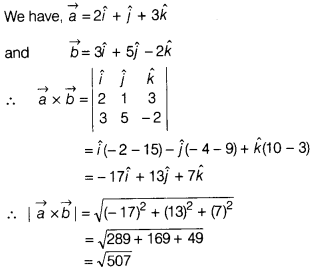
Question 22.
Find the area of the region bounded by the curve y = cos x
between \(\frac{\pi}{2}\) to \(\frac{3\pi}{2}\).
Solution:
We have, y =
cos x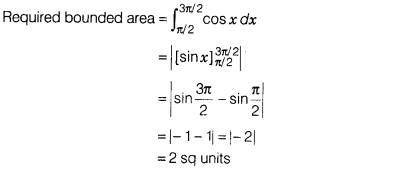
Here. -2 represents that the area of the required region is
below the X-axis.
Question 23.
Evaluate ∫\(\frac{1}{\sqrt{9+8x-x^2}}\)
Or
Evaluate ∫x
log x dx
Solution: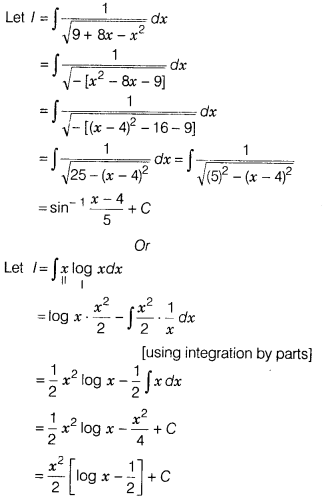
Question 24.
Show that the function x + \(\frac{1}{x}\) is increasing for
x > 1.
Solution: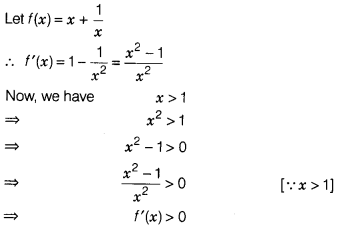
Hence, f(x) is increasing for x > 1.
Question 25.
so that A² = 8A + KI
Solution:
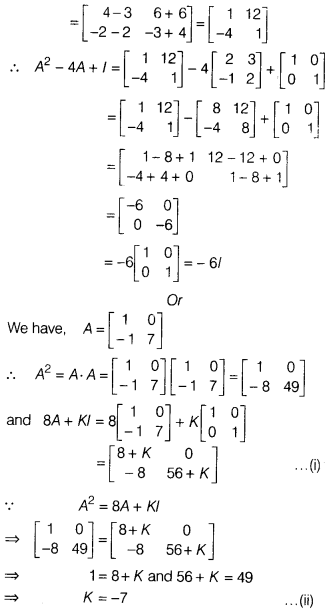
Section
C
This section comprises of short
answer type questions (SA) of 3 marks each
Question 26.
Find the value of c, for which the vectors
\(\vec{a}=(c
log_2 x)\hat{i}-6\hat{j}+3\hat{k}\) and
\(\vec{b}=(log_2
x)\hat{i}+2\hat{j}+(2c log_2 x)\hat{k}\) make an obtuse angle for any x ∈ (0,
∞).
Solution: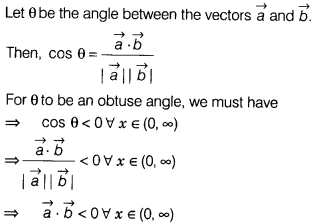
⇒ c(log2 x)² – 12 + 6c(log2 x) < 0 ∀
x ∈ (0, ∞)
⇒ cy² + 6cy -12 < 0 ∀ y ∈ R,
where y = log2x [∵ x
> 0 ⇒ y = log2 x ∈ R]
⇒ c <0 and 36c² + 48c <0
[∵ ax²
+ bx + c <0 ∀ x ⇒ a < 0 and discriminant < 0]
⇒ c < 0 and c (3c +
4) < 0
⇒ c < 0 and –\(\frac{-4}{3}\) < c < 0
⇒ c ∈
(\(\frac{-4}{3}\), 0
Question 27.
If y = xx, then prove that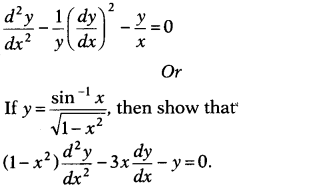
Solution:
Given, y = xx
On taking log both
sides, we get log y = log xx
⇒ logy = xlog x
On differentiating
both sides w.r.t. x, we get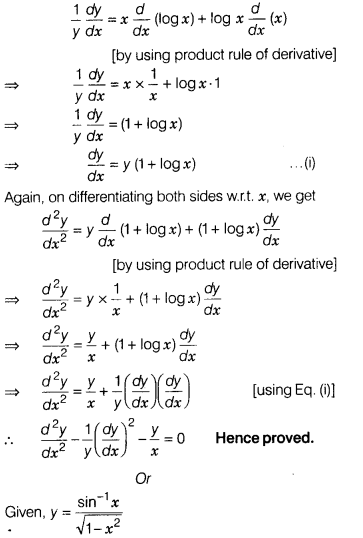
On differentiating both sides w.r.t. x, we get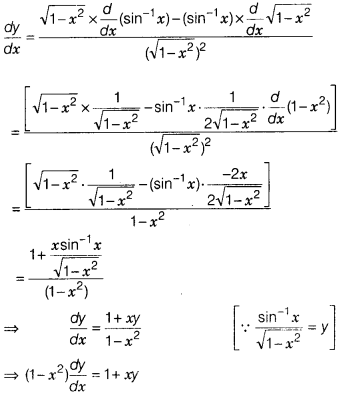
On differentiating both sides of above equation w.r.t. x,
get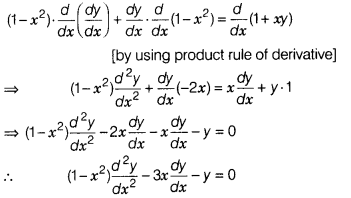
Question 28.
Show that the function f : R → R defined by f(x) =
\(\frac{3x-1}{2}\), x ∈ R is one-one and onto functions.
Solution:
Given,
f(x) = \(\frac{3x – 1}{2}\), x ∈ R
For one-one Let x1,
x2 ∈ R such that f(x1) = f(x2)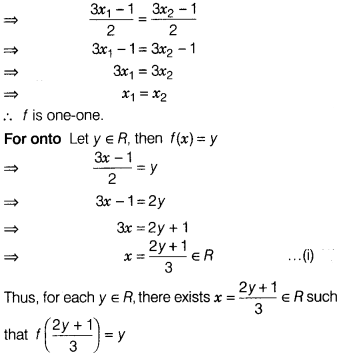
Hence, f is onto.
So, f is one-one and onto. Hence
proved.
Question 29.
Find the particular solution of the differential equation (1
+ e2x) dy + (1 + y²) exdx = 0, given that y = 1, when x =
0.
Or
Solve the following differential equation y²dx + (x² – xy + y²) dy =
0.
Solution:
Given, differential equation is
(1 + e2x)dy +
(1 + y²) exdx = 0
⇒ (1 + e2x)dy = -(1 +
y²)exdx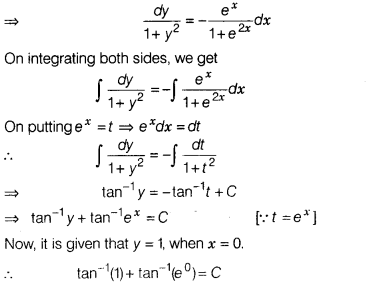
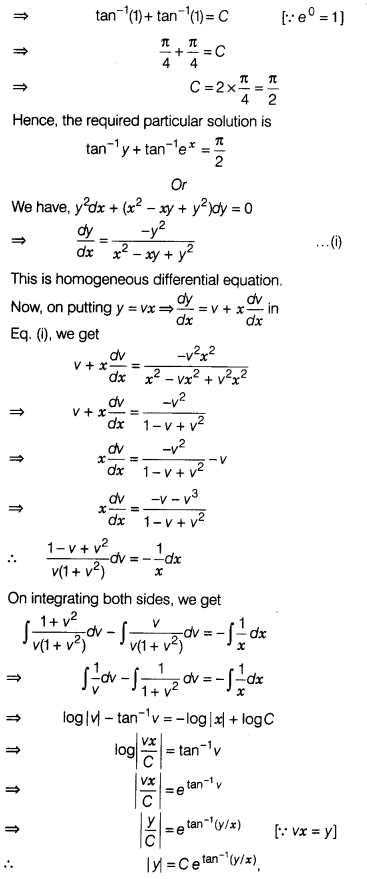
which is the required solution.
Question 30.
Find whether the following function is differentiable at x =
1 and x = 2 or not.
Solution: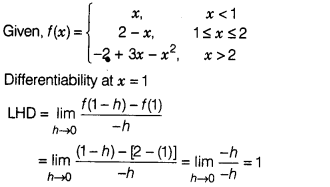
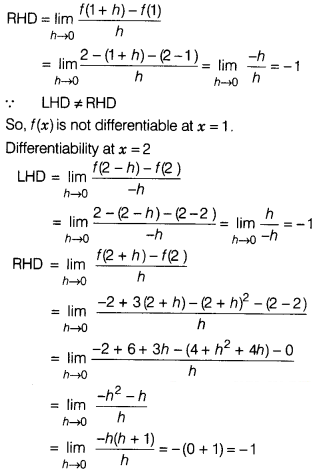
∵ LHD = RHD
So, f (x) is differentiable at x = 2.
Hence, f(x) is not differentiable at x = 1, but it differentiable at x = 2.
Question 31.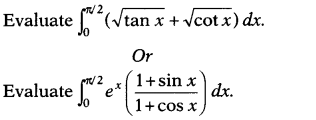
Solution: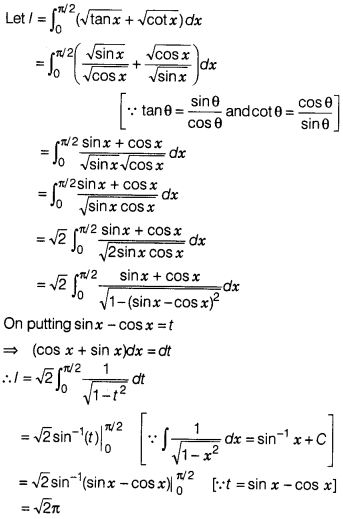
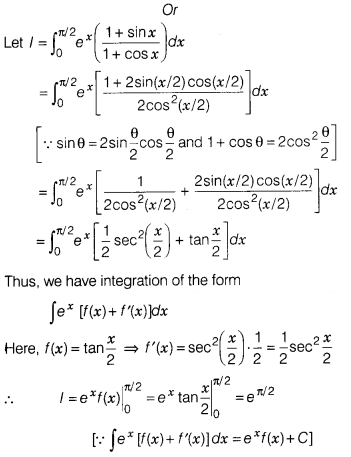
Section
D
This section comprises of long
answer type questions (LA) of 5 marks each
Question 32.
Show that area of the parallelogram, whose diagonals are
given by \(\vec{a}\) and \(\vec{b}\) is
\(\frac{|\vec{a}\times\vec{b}|}{2}\).
Or
Find the area of the
parallelogram, whose diagonals are \(2\hat{i}-\hat{j}+\hat{k}\) and
\(\hat{i}+3\hat{j}-\hat{k}\).
Solution: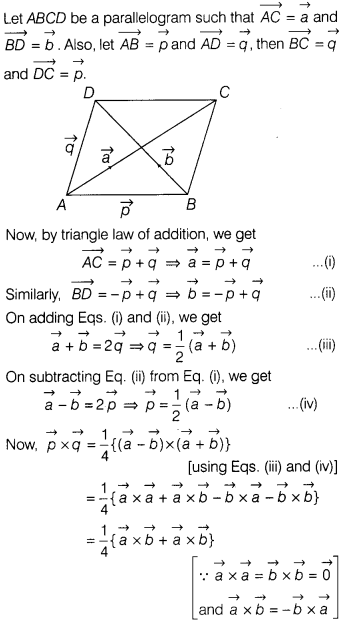
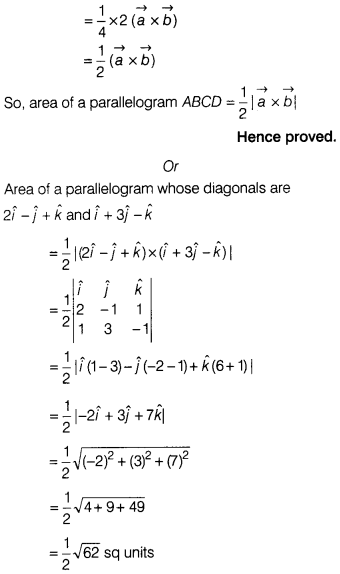
Question 33.
Find the equation of line joining P(11, 7) and Q(5, 5) using
determinants. Also, find the value of k, if R(-1, k) is the point such that area
of ∆PQR is 9 sq m.
Solution:
Let A(x, y) be any point on line PC.
Then,
the points P, Q and A are collinear.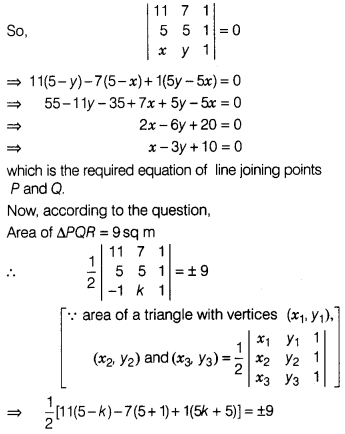
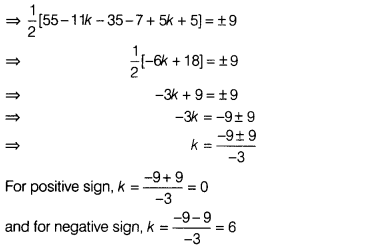
Hence, the required values of k are 0 and 6.
Question 34.
Maximise Z = 8x + 9y subject to the constraints given
below
2x + 3y ≤ 6, 3x – 2y ≤ 6, y ≤ 1, x, y ≥ 0.
Or
Solve minimise Z =
5x+ 7y
Subject to constraints
2x + y ≥ 8; x + 2y ≥ 10, x, y ≥ 0
Solution:
We have the following LPP
Maximise Z = 8x + 9y
Subject to the
constraints
2x + 3y ≤ 6
3x – 2y ≤ 6
y ≤ 1 and x, y ≥ 0
Now,
considering the inequations as equations, we get
2x + 3y = 6 ….(i)
3x – 2y
= 6 …(ii)
and y = 1 …(iii)
Table for line 2x + 3y = 6 is
| x | 3 | 0 |
| y | 0 | 2 |
So, it passes through the points, (3, 0) and (0, 2).
On putting (0, 0) in
the inequality 2x + 3y ≤ 6, we get
0 ≤ 6 [which is true]
So, the half
plane is towards the origin.
Table for line 3x – 2 y = 6 is
| x | 2 | 0 |
| y | 0 | -3 |
So, it passes through the points (2, 0) and (0, -3). On putting (0,0) in the
inequality 3x – 2y ≤ 6, we get
0 ≤ 6 [which is true]
So, the half plane is towards the origin.
The line y = 1 is perpendicular
to Y-axis.
On putting (0,0) in the inequality y < 1, we get
0 < 1
[which is true]
So, the half plane is towards the origin.
Also, x ≥ 0, y ≥
0, so the feasible region lies in the first quadrant.
The point of
intersection of Eqs. (i) and (ii) is (\(\frac{30}{13}\), \(\frac{6}{13}\))
Eqs. (ii) and (iii) is (\(\frac{8}{3}\), 1) and Eqs.(i) and (iii) is
(\(\frac{3}{2}\), 1)
The graphical representation of the above system of inequations is given
below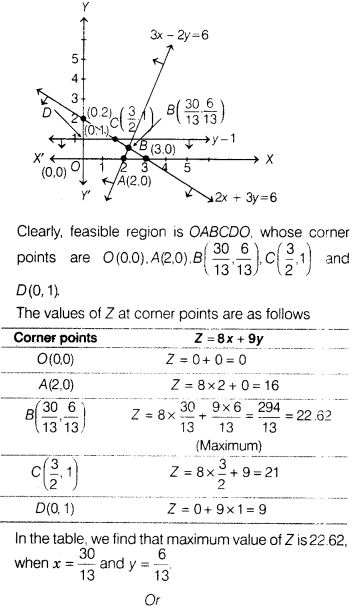
To solve the LPP graphically, we first convert the
inequations into equations to obtain the following lines.
2x + y = 8,
x +2
y = 10.
x = 0. y = 0
The line 2x + y = 8 meets the coordinate axes at
A1(4, 0)and B1(0, 8), join these points to obtain the line
represented by 2x + y = 8.
Clearly, 0(0,0) does not satisfy the inequation 2x
+ y ≥ 8.
So, the region not containing the origin is represented by this inequation.
The line x + 2y = 10 meets the coordinate axes at A2(10, 0)and
S2(0, 5). Join these points to obtain the line represented by x + 2y
= 10.
Clearly, 0(0, 0) does not satisfy the inequation x + 2y ≥ 10.
So, the region not containing the origin is represented by this inequation. Clearly.x ≥ 0 and y ≥ 0 resprcsent the first quadrant.
Thus, the shaded region in figure is the feasible region of the LPP The
coordinates of the corner points of this region are A2(10, 0), P(2,
4) and B1(0, 8).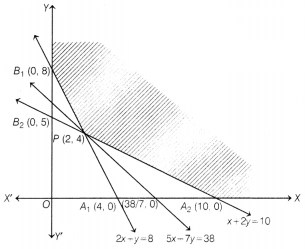
The,point P(2, 4) is obtained by solving 2x + y = 8 and x + 2y = 10 simultaneously. The values of the objective function Z = 5x + 7y at the corner points of the feasible region are given in the following table
| Point (x, y) | Value of the objective function Z = 5x + 7y |
| A2(10, 0) | Z = 5 × 10 + 7 × 0 = 50 |
| P(2, 4) | Z = 5 × 2 + 7 × 4 = 36 |
| B1(0, 8) | Z = 5 × 0 + 7 × 8 = 56 |
Clearly, Z is minimum at x = 2 and y = 4.
Question 35.
Find the area under the curve y = \(\sqrt{3x+4}\) between x =
0, x = 4 and the X-axis.
Solution:
Given, curve is y = \(\sqrt{3x+4}\)
On squaring both sides, we get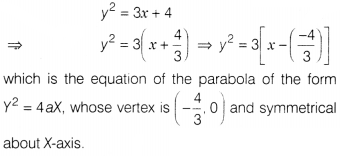
As, y = \(\sqrt{3x+4}\) is a positive square root, so we take a upper part of the parabola, y² = 3x + 4
The area of the region bounded by the curve y = \(\sqrt{3x+4}\) between x =
0, x = 4 and the X-axis, is the area shown in the figure given below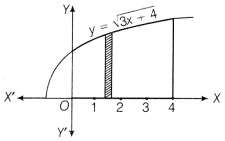
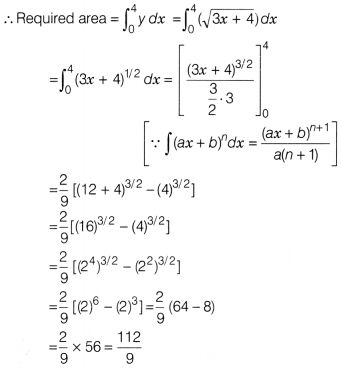
Hence, the required area is \(\frac{112}{9}\)sq units.
Section
E
This section comprises of 3
case-study/passage-based questions of 4 marks each
Question 36.
A school wants to form a poster for advertisement purpose.
The top and bottom margins of poster should be 10 cm and the side margins should
be 6 cm. Also, the area for printing the advertisement should be 1200
cm².
Based on the above information, answer the following questions.
(i)
If b cm be the width and h cm be the height of poster, then find the ai ea of
poster, expressed in terms of b and h.
(ii) Find the relation between b and
h.
(iii) Find the value of h, so that the area of the poster is
minimised.
Or
Find the value of b, so that area of the poster is
minimised.
Solution:
(i) Let the area of the poster be A, then
A = 1200
+ 2(b . 10) + 2(h . 6) – 4(6 . 10)
= 1200 + 20b + 12h – 240
= 960 + 20b +
12b
(ii) The relation between b and h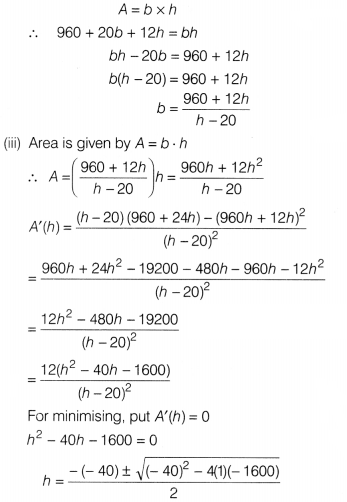
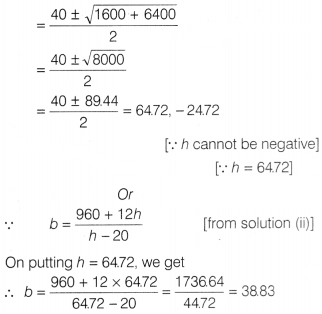
Hence, the required value of b is 38.83 cm.
Question 37.
Integration is the process of finding the antiderivative of a
function. In this process, we are provided with the derivative of a function and
asked to find out the function (i.e. primitive) integration is the inverse
process of differentiation.
Let f(x) be a function of x. If there is a
function g(x), such that \(\frac{d}{dx}\)[g(x)] = f(x), then g(x) is called an
integral of f(x) w.r.t.x and is denoted by ∫f(x)dx = g(x) + C, where C is
constant of integration.
Based on the above information, answer the following
questions.
(i) ∫(3x + 4)³dx is equal to
(ii)
∫\(\frac{(x+1)^2}{x(x^2+1)}\)dx is equal to
(iii) ∫sin² x dx is equal to
Or
∫tan² x dx is equal to
Solution:
(i) We know that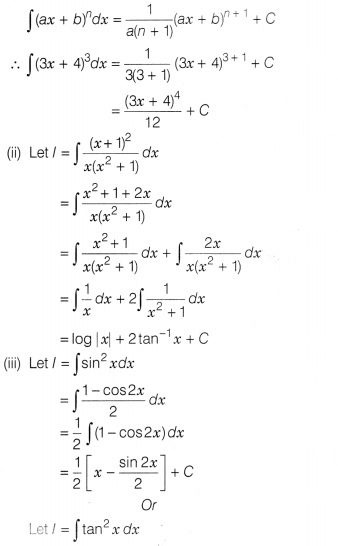

Question 38.
In a bolt factory, machines A, B and C manufactured
respectively, 25%, 35% and 40% of the total bolts. Of their output 5%, 4% and 2%
are respectively, defective bolts.
Based on the above information, answer the
following questions.
(i) Find the probability, if drawn bolt is defective,
then it is manufactured by A.
(ii) If drawn bolt is defective, then find the
probability that it is not manufactured by B.
Solution:
Consider the
following events
E1 = Bolt is manufactured by machine A
E2 = Bolt is manufactured by machine B
E3 = Bolt is
manufactured by machine C
F = Drawn bolt is defective
We have,